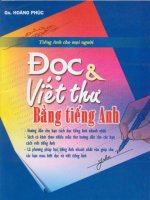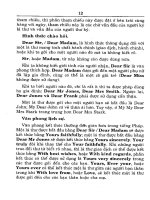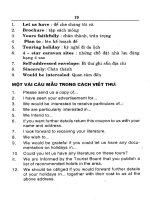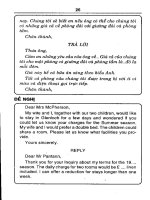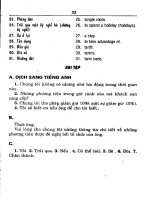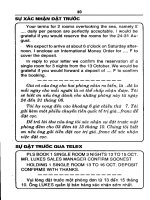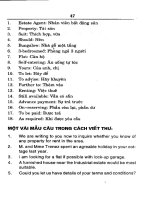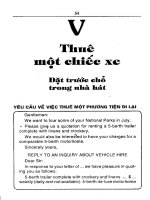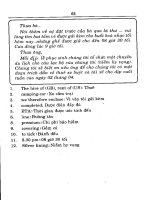MINISTRY OF EDUCATION AND TRAINING HUE COLLEGE OF AGRICULTURE AND FORESTRY - A COURSE OF ENGLISH pptx
Bạn đang xem bản rút gọn của tài liệu. Xem và tải ngay bản đầy đủ của tài liệu tại đây (1.9 MB, 128 trang )
MINISTRY OF EDUCATION AND TRAINING
HUE COLLEGE OF AGRICULTURE AND FORESTRY
0o0
A COURSE OF
ENGLISH in AGRICULTURE
Course Designer: LE THI THANH CHI (M.A)
HUE – 12/2008
2
“A course of English in Agriculture” là giáo trình tiếng Anh chuyên ngành có thể
dùng làm tài liệu giảng dạy cho sinh viên ngành khuyến nông, ngành nông lâm kết hợp và
làm tài tiệu tham khảo cho các ngành học về Nông Lâm cơ bản như: trồng trọt, làm vườn,
kỹ thuật nông lâm của trường Đại Học Nông Lâm và Đại Học Sư Phạm (ngành kỹ
thuật Nông Lâm).
Giáo trình này được biên soạn trên cơ sở sinh viên đã học qua chương trình tiếng
Anh cơ bản; có vốn kiến thức cơ bản về ngữ pháp tiếng Anh và kiến thức cơ bản về các
chuyên ngành liên quan đến cây trồng và vật nuôi; sinh viên có nhu cầu phát triển kỹ
năng đọc, viết và dịch tiếng Anh chuyên ngành nông lâm. Do đó mục đích của giáo trình
là:
Giúp sinh viên làm quen với văn phong tiếng Anh khoa học kỹ thuật.
Rèn luyện kỹ năng đọc hiểu các văn bản khoa học.
Cung cấp cho sinh viên các từ, thuật ngữ chuyên ngành.
Luyện thực hành viết và dịch một số cấu trúc ngữ pháp thường gặp.
Với đối tượng của giáo trình là sinh viên năm thứ 3 trường Đại Học Nông Lâm Huế và
thời lượng dành cho môn học là 60 tiết (4 đơn vị học trình), “A course of English in
Agriculture” gồm 7 units và một số bài đọc thêm. Các bài text được trích dẫn hoặc phỏng
theo các tài liệu khoa học nhằm đảm bảo tính xã thực của văn bản. Các bài tập ngữ pháp
được biên soạn theo ngữ pháp tiếng Anh cơ bản và kết hợp các kiến thức chuyên ngành
nông lâm cơ bản mà sinh viên đã được học.
Sinh viên chuyên ngành khuyến nông có thể tham khảo thêm phần phụ lục
(appendix) để luyện tập thêm kỹ năng đọc hiểu, trau dồi thêm vốn từ vựng chuyên ngành
và tìm hiểu thêm các thông tin về chuyên ngành.
Việc biên soạn giáo trình này chắc chắn không tránh khỏi những khiếm khuyết.
Chúng tôi mong nhận được góp ý xây dựng của độc giả và người học để giáo trình ngày
càng hoàn thiện hơn.
LỜI MỞ ĐẦU
3
Lê Thị Thanh Chi
TABLE OF CONTENTS
Page
Unit 1: Plant (1) ………………
Unit 2: Plants (2) ……………………………
Unit 3: Soils ………………………………………
Unit 4: Water in the Soil ……………………………
Unit 5: Livestock ………………………………
Unit 6: Forestry ………………………
Unit 7: Farm Management ………………………
Further reading
Farm Record
Food Crop
Agriculture Extension
Appendix
References
4
16
30
45
57
68
81
89
93
95
126
0o0
4
UNIT ONE: PLANTS (1)
I. READING AND COMPREHENSION
A. Reading text:
Plant Groups
1 Plants can be divided into annuals, biennials, and perennials according to their total
length of life.
Annuals
2 Typical examples are wheat, barley and oats which complete their life history in one
growing season, i.e. starting from the seed, in 1 year they develop roots, stem and leaves and then
produces flowers and seed before dying.
Biennials
3 These plants grow for two years. They spend their first year in producing roots, stem and
leaves, and the following year in producing the flowering stem and seeds, after which they die.
4 Sugar beet, swedes and turnips are typical biennials, although the grower treats these
crops as annuals, harvesting them at the end of the first year when all the foodstuff is stored up in
the root.
Perennials
5 They live for more than 2 years and, once fully developed, they usually produce seeds
each year. Many of the grasses and legumes are perennials
The Life Cycle of A Plant
6 The life cycle of a typical annual plant can be divided into several stages. The first stage
is germination. Seeds remain dormant, or in a resting state, is they are kept cool and dry. When
the amount of moisture and the temperature level are right, the seeds germinate and start growing.
7 Certain conditions are necessary for this to happen. An essential condition is that the
seeds must be alive. Sometimes seeds are dried at the temperature which is too high. This has two
effects: the water content in the seeds is reduced too much, and certain essential proteins are
destroyed. As a result, the seeds die.
8 Other conditions for germination concern the amount of moisture in the soil. If dry seeds
are planted in a dry soil, they will not germinate until it rains. On the other hand, if there is too
much water in the soil, the seeds will not germinate either. This is because wet soils remain cold
for a longer period of time than drier, well-drained soils. If the soil is too cold germination will
not occur. An additional reason for seeds not germinating is that badly drained soils may lack
sufficient oxygen. Dormant seeds require very little oxygen in order to stay alive, but when they
start to germinate they require more.
9 In the first stage of germination the primary root, or radicle, emerges. Then the stem
pushes its way upward until it appears above the surface of the soil. At the same time the root
system grows downward, and begins to spread through the soil. In the early stages of
5
development the seedling depends entirely on the food stored in the seed but as soon as the first
leaves are produced, it is able to manufacture food for itself. The seedling begins photosynthesis.
10 Next the plant enters the stage of rapid growth. In this stage of the life cycle, the plant
begins to grow to its full size. When it is mature enough, it flowers, and when this happens
pollination and fertilization are ready to take place. In the process of pollination the pollen is
carried by wind or insects from the stamens to the stigma of the carpel. It germinates on the
stigma and grows down the style into the ovary, where fertilization takes place.
(Adapted from "the life cycle of a plant", English in Agriculture, Alan Mountford)
II. Comprehension questions:
1. Explain the differences between an annual, a biennial and a perennial.
2. From the above text, infer these statements are true or false:
a. Before a seed germinates it is in a dormant state.
b. When the temperature level is right a seed will germinate.
c. If seeds are dried at too high a temperature they will not die.
d. If the soil is too dry seed will not germinate.
e. The temperature of wet soils is higher than that of well-drained soils.
f. Dormant seeds cannot stay alive in a badly drained soil.
g. The root system forms before the stem appears above the surface of the soil.
h. The seed contains enough food to nourish the seedling until the first eaves are
produced.
III. Vocabulary:
1. In paragraph 7, line 1 this refers to:
a. the life cycle of a plant.
b. the germination of a seed.
c. the right temperature level.
2. In paragraph 7, line 3 this refers to:
a. too high a temperature.
b. the drying of seeds.
c. the condition that seeds must be alive.
3. In paragraph 10, line 3 this happen refers to:
a. when the plant begins to grow to its full size.
b. when the plant enters the stage of rapid growth.
c. when the plant flowers.
4. Rewrite the following sentences replacing the words printed in italics with expressions
from the text which have the same meaning.
6
a. The seed starts growing when there is enough air or water and the temperature is
right. (par. 6)
b. A seed will only germinate when there is enough air in the soil. (par. 8)
c. Seeds which are in a resting state require very little air to remain alive. (par. 8)
d. As soon as the stem and leaves appear above the surface of the soil, they begin to
manufacture food. (par. 9)
e. After the plant has appeared above the surface of the soil it enters the stage of life
when its begins to grow to its full size. (par. 10)
f. The process of carrying the pollen to the stigma is brought about by wind or insects.
(par. 10)
B. GRAMMAR:
EXERCISE A: Time expressions (1): after, before, when, as soon as, while
Look at these sentences:
First the seed is provided with water, warmth and air, then it starts to germinate.
After the seed is provided with water, warmth and air, it starts to germinate.
Now rewrite the following sentences in the same way, choosing one of the time expressions
given in the brackets and putting it at the beginning of the sentence as indicated (/). Omit the
words in italics.
1. /The seedling begins to manufacture food for itself. But first it uses up the food stored in
the seed. (when, before, after)
2. /The young shoot appears above the surface of the ground. Then it begins the process of
photosynthesis. (before, as soon as, while)
3. Once /the oxygen has combined with and broken down the various complex sugars,
energy is released. (before, after, while)
4. / Dormant seeds are inactive. During this time they use very little air. (when, before,
while)
5. / The young rice plants are transplanted to the paddy fields. But first they are grown in
nurseries for a few weeks where proper care can be given to the seedlings. (before,
while, after)
6. Once / the shoot appears, the plant then grows both above and below the ground. (when,
while, after).
7. During the time / the seedlings are small, there are few leaves present to use sunlight for
photosynthesis. (while, before, as soon as)
8. / A crop of nitrogen-fixing legumes was ploughed in. As a result the next crop produced
a higher yield. (while, until, after)
7
9. / The spores of disease organisms land on the plant. At the same time they are killed by
the fungicide which has been sprayed or dusted on to the plant surfaces. (as soon as,
while, before)
10. / Sometimes there is too much water in the soil. On these occasions it must be drained
off. (after, until, when)
EXERCISE B: Time expressions (2): Then, during, throughout, prior to, first
Compare the following sentences with your answers to Exercise A. If the sentences have
approximately the same meaning put a tick in the box, if not put a cross. The first two have been
done for you.
1. Prior to the seedling manufacturing food for itself, it uses up the food stored in the seed.
2. The process of photosynthesis begins and then the young shoot appears above the surface
of the ground.
3. Oxygen combines with and breaks down the various complex sugars prior to energy
being released.
4. Throughout the time that dormant seeds are inactive they use very little air.
5. The young rice plants are transplanted to the paddy fields and then they are grown in
nurseries for a few weeks where proper care ca be given to the seedlings.
6. Prior to the shoot appearing the plant grows above and below the ground
7. There are few leaves present to use sunlight for photosynthesis through the time that the
seedlings are small.
8. During the time nitrogen-fixing legumes were ploughed in, the next crop produced a
higher yield.
9. If the spores of disease organisms land on the plant they are killed by the fungicide
which has been sprayed or dusted on to the plant surface.
10. If there is too much water in the soil it must be drained off.
EXERCISE C: Expressions of degree: too and enough
Part 1: Rewrite the following sentences using too and make any other changes that are
necessary. The first two have been done for you.
(a) The soil was dry so the seed could not germinate.
Or The soil was too dry for the seed to germinate.
(b) The soil was heavy and clayey and, as a result, it was unsuitable for root crops.
Or The soil was too heavy and clayey to be suitable for root crops.
1. The soil particles are fine so the water cannot percolate easily through the soil.
2. Because the soil was compact, it was not suitable for root crops.
3. Soil aeration was inadequate and consequently the plant could not receive a proper
supply of oxygen.
8
4. As a result of the land being waterlogged, it was not possible to produce a healthy crop.
5. The soil profile was so shallow that it could not give the roots sufficient anchorage.
6. As the root system was poorly developed, the plant could not produce a good top growth.
7. It was dark and as a result photosynthesis could not take place.
8. The current was swift so that the silt would not be deposited.
Part 2: Now look at the sentences you have written and rewrite them using not + adjective
+ enough, using the adjective given for each sentence.
Examples: - The soil was too dry for the seed to germinate. (wet)
= The soil was not wet enough for the seed to germinate.
- The soil was too heavy and clayey to be suitable for root crops. (light and sandy)
= The soil was not light and sandy enough to be suitable for root crops.
1. coarse; 2. Loose; 3. Adequate; 4. Well-drained;
5. Deep; 6. Well-developed; 7. Bright; 8. Slow.
III. LANGUAGE IN USE:
EXERCISE A: Labeling of diagram
Complete the labeling of the following diagram by inserting the correct labels from the list
of words and phrases below.
9
Figure 1. The life cycle of a plant
Fruit and seed production
Photosynthesis begins
Plant flowers
Seed dispersal
Decay of vegetative parts
Pollination and fertilization
Stage of rapid vegetable grown
Germination
EXERCISE B:
Look at the following stages in the growth of a plant (the French bean):
A. The seed is dormant. (stage 1)
B. Germination begins
The seed absorbs water. (stage 2)
The seed swells. (stage 3)
C. The radicle enlarges (stage 4)
The radicle bursts through the testa. (stage 5)
D. The radicle elongates. (stage 6)
E. Lateral roots develop. (stage 7)
The hypocotyl grows. (stage 8)
10
F. The hypocotyl pulls the cotyledons out of the earth.
G. The plumule remains between the cotyledons. (stage 9)
The hypocotyl straightens. (stage 10)
The cotyledons separate. (stage 11)
H. The cotyledons photosynthesis for a few days. (stage 12)
The cotyledons shrivel. (stage 13)
The cotyledon fall off. (stage 14)
Part 1: Time clauses and the conjunctions when, as, after, before, until
Now read these examples and then complete the sentences:
Example: The seed remains dormant until germination begins.
When the seed absorbs water, it swell.
1. When the radicle enlarges,
2. , lateral roots develop.
3. When the hypocotyl grows,
4. The plumule remains between the cotyledons until
5. , the cotyledons separate.
6. The cotyledons photosynthesize for a few days until …
Part 2: Reduced time clauses (conjunction + -ing phrase)
Look at these sentences
When the seed absorbs
water, it swells
Or
On absorbing water, the
seed swells.
After the radicle bursts
through the testa, it elongates.
Or
After bursting through
the testa, the radicle elongates.
Before the hypocotyls
straightens, it grows.
Or
Before straightening, the
hypocotyls grows.
(a) Fill in the correct word at the beginning of the following sentences:
1. … the hypocotyls pulls the cotyledons out of the earth, it straightens.
2. … the radicle enlarges, it bursts through the testa.
3. … the cotyledons shrivel, they separate.
(b) Now change each of the sentence, using the form on/before/after + …ing
(c) Use the new structures of the above exercises to write a short paragraph of the
germination of the French bean (by linking the stages of its growth).
EXERCISE C: Nominalisation of verb forms and adverbial phrases of time
Look at these sentences:
11
After the seed is dormant, it
germinate.
Or
After dormancy, the seed germinate/ Germination
occurs.
Before the lateral roots develop,
the radicle elongates.
Or
Before development of the lateral roots, the radicle
elongates / Elongation of the radicle takes place.
As the seed germinates, it absorbs
water.
Or
During germination, the seed absorbs water /
Absorption of water occurs.
Now copy and complete this table. Look up words in your dictionary where necessary.
Verb
Noun
Absorb
Dormant
Develop
Germinate
Enlarge
Grow
Separate
Photosynthesize
…
…
…
…
…
…
…
…
READING TEST:
Complete the following text by filling in the blank spaces with the expressions given
below. A dotted line … requires a phrase to be added and a straight line ____ requires a word.
Root system
colder
seeds
temperature
germination (3 times)
downwards
not
life
up
rapid growth
too high
too much
testa
photosynthesis
little moisture
in the soil
water and air
destroyed
may be reduced
sufficient air
temperature level
food manufacture
well-drained soils
dependent on the food store
secondary roots
surface of the soil
mature
The first stage in the life cycle of a plant is ____ . Certain conditions are necessary for ____
to occur. Firstly, the ____ must be alive. If seeds are dried at … a temperature, the water
content in the seeds … too much and certain essential proteins ____ . Secondly, the amount of
moisture in the soil must be right. If there is too … in the soil, seed will not germinate.
12
However, if there is … water in the soil, seed will ____ germinate either because wet soil tend
to be ____ than drier, … This is the third condition necessary for germination to occur. The
… of the soil must be right. A fourth condition concerns the amount of air … A wet, badly
drained soil may lack … for seeds to germinate. Thus, we may say that ____ only happens
under the right conditions; when there is ____, sufficient … , and the right ____ .
The first stage in the germination of, for example, a bean is the splitting of the ____. The
radicle emerges and starts to grow ____. Next, the curved plumule begins to grow ____ toward
the light. Meanwhile, the … is beginning to spread through the soil. In these early stage of
development, the seedling is entirely … in the seed. After the young plant has broken the …
and the first leaves are produced … by ____ can begin. By this time, below the soil surface
… are developing. The plant is ready to begin the stage of … during which it grows to its full
____ size.
New words and expressions:
- biennial (n.):
- perennial (n.):
- barley (n.):
- turnips (n.):
- germination (n.):
- dormant (adj.):
- moisture (n.):
- well-drained soil:
- sufficient (adj.):
- radicle (n.):
- the surface of the soil:
- seedling (n.):
- manufacture (v.):
- photosynthesis (n.):
- pollination (n.):
- pollen (n.):
- stamen (n.):
- stigma (n.):
- carpel (n.):
- ovary (n.):
- fertilization (n.):
(cây) hai năm
(cây) lưu niên, nhiều năm
đại mạch
cây củ cải
sự nảy mầm
nằm im lìm, không hoạt động, ngủ
độ ẩm
đất tiêu thoát tốt
đủ, đầy đủ
rễ mầm, rễ con
bề mặt đất trồng
cây con, cây giống
sản xuất
quang hợp
sự thụ phấn
hạt phấn
nhị hoa
núm nhụy (hoa)
lá noãn
bầu nhụy
sự thụ phấn
13
- transplanted:
- paddy field:
- nurseries:
- yield (n.):
- spores (n.):
- anchorage (n.):
- coarse (adj.):
- seed dispersal:
- elongate (v.):
- testa (n.):
- hypocotyls (n.):
- cotyledon (n.):
- shrivel (v.):
được cấy vào
cánh đồng lúa nước
ruộng ươm
sản lượng
bào tử
sự bám chặt
thô
sự phát tán hạt
kéo dài ra
vỏ ngoài của hạt, vỏ bọc
trụ dưới lá mầm
lá mầm
nhăn nheo, xoăn lại
0o0
14
LANGUAGE SUMMARY
Using adverb clauses to show time relationships:
after
(a)After she graduates, she will get a job.
(b) After she (had) graduated, she got a job
A present tense, not a future tense
is used in an adverb clause of
time. Notice example (b) and (d).
before
(c) I will leave before he comes.
(d) I (had) left before he came.
when
(e) When I arrived, he was talking on the phone.
(f) When I got there, he had already left.
(g) When it began to rain, I stood under a tree.
(h) When I was in Chicago, I visited the museum.
(i) When I see him tomorrow, I will ask him.
When = at that time
(notice the different time
relationship expressed by the
tenses)
While
As
(j) While I was walking home, it began to rain.
(k) As I was walking home, it began to rain.
While, as = during that time
By the time
(l) By the time he arrived, we had already left.
(m) By the time he comes, we will already have left.
By the time = one event is
completed before another event.
(notice the use of the past perfect
and future perfect in the main
clause)
Since
(n) I haven‟t seen him since he left this morning.
Since = from that time to the
present. (Notice the present
perfect is used in the main clause)
Until
till
(o) We stayed there until we finished our work.
(p) We stayed there till we finished our work.
Until, till = to that time and then
no longer (till is used primarily in
speaking rather than writing)
As soon as
Once
(q) As soon as it stops raining, we will leave.
(r) Once it stops raining, we will leave.
As soon as, once = when one
event happens, another event
happens soon afterwards.
As long as
So long as
(s) I will never speak to him again as long as I live.
(t) I will never speak to him again so long as I live
As soon as, so long as = during
all that time, from beginning to
end.
Whenever
Every time
(u) Whenever I see her, I say hello.
(v) Every time I see her, I say hello.
Whenever = every time
The first time
The last time
The next time
(w) The first time I went to New York, I went to an opera.
(x) I saw two plays the last time I went to New York.
(y) The next time I go to New York, I‟m going to see a
ballet.
Adverb clauses can be introduced
by the following:
first
The second time
third
last
next
15
FURTHER PRACTICE
A. Complete the following. Pay attention to verb tenses.
1. Last night I went to bed after I _________ my homework.
2. Tonight I will go to bed after I ______________ my homework.
3. Ever since I was a child, I _________ afraid of dogs.
4. Jane‟s contact lens popped out while she basketball.
5. Be sure to reread your composition for errors before you __________ it in to
the teacher tomorrow.
6. By the time I left my apartment this morning, the mail carrier _____ the mail.
7. I have known Jim Bates since he ___________ ten years old.
8. A black cat ran across the road as I ____________ my car to work this
morning.
9. By the time I leave this city, I ___________ here for four months.
10. Whenever Mark __________ angry, his nose gets red.
11. I __________ to the beach whenever the weather was fine, but now I don‟t
have time to do that because I have to study.
12. We will have a big party when _____________.
13. The next time I _________ to Hawaii, I‟m going to visit Mauna Loa, the
world largest volcano.
14. I had fried chicken the last time I ___________ at that restaurant.
B. Complete the following sentences. Punctuate carefully. Pay attention to verb
tense usage.
1. Just as I was falling asleep last night
2. I‟ll help you with your homework as soon as I
3. as long as I live.
4. Just before I
5. The last time I
6. I had already when
7. Whenever
8. I will be here until I
o0o
16
UNIT TWO: PLANTS (2)
A. READING AND COMPREHENSION:
I. Reading text:
1 Plants are living organisms consisting of innumerable tiny cells. They differ from
animals in many ways but the most important difference is that plants can build up valuable
organic substances from simple materials. The most important part of this building process,
which is called photosynthesis, is the production of carbohydrates such as sugars, starches and
cellulose.
Photosynthesis
2 In photosynthesis a special green substance called chlorophyll uses light energy
(normally sunlight) to change carbon dioxide and water into sugar (carbohydrates) in the green
parts of the plant. The daily amount of photosynthesis is limited by the duration and intensity of
sunlight. The amount of carbon dioxide available is also a limiting factor. Shortage of water and
low temperatures can also reduce photosynthesis.
3 The cells which contain chlorophyll also have yellow pigments such as carotene. Crop
plants can also build up chlorophyll in the light and so any leaves which develop in the dark are
yellow and cannot produce carbohydrates.
4 Oxygen is released during photosynthesis and the process may be set out as follows:
Carbon dioxide + water + energy carbohydrates + oxygen
NCO
2
nH
2
O (light) = (CH
2
O)n nO
2
Carbohydrates
5 This process not only provides the basis for all our food but it also supplies the oxygen
which animals and plants need for respiration.
6 The simple carbohydrates, such as glucose, may build up to form starch for storage
purposes, or to cellulose for building cell walls. Fats and oils, are formed from carbohydrates.
Protein material, which is an essential part of all living cells, is made from carbohydrates and
nitrogen compounds.
The parts of a plant
7 Most plants consist of roots, stems, leaves and reproductive parts and need soil in which
to grow.
8 The root spread through the spaces between the particles in the soil and anchor the plant.
In a plant such as wheat the root system may total many miles.
9 The leaves, with their broad surfaces, are the main parts of the plant where
photosynthesis occurs (see Figure 2)
17
Figure 2. Photosynthesis illustrated diagrammatically
10 A very important feature of the leaf structure is the presence of large numbers of tiny
pores (stomata) on the surface of the leaf (see Figure 3)
There are usually thousands of stomata per square cm of leaf surface. Each pore (stoma) is
oval-shaped and surrounded by two guard cells. When the guard cells are turgid (full of water)
the stoma is open and when they lose water the stoma closes.
Figure 3. Stomata on leaf surface.
18
11 The carbon dioxide used in photosynthesis diffuses into the leaf through the stomata and
most of the water vapour leaving the plant, and the oxygen from photosynthesis diffuses out
through the stomata.
Transpiration
12 The evaporation of water from plants is called transpiration. It mainly occurs though the
stomata and has a cooling effect on the leaf cells. Water in the cells of the leaf can pass into the
pore spaces in the leaf and then out through the stomata as water vapour (see Figure 4).
Figure 4. Cross-section of green leaf showing gaseous movements during daylight.
13 The rate of transpiration varies considerably. It is greatest when the plant is well
supplied with water and the air outside the leaf is warm and dry. In very hot or windy weather
water evaporates from the guard cells and so the stomata close and reduce the rate of
transpiration. The stomata also close in very cold weather, e.g. 0
0
C.
14 The rate of loss is reduced if the plant is short of water because the guard cells then lose
water and close the stomata; it is also retarded if the humidity of the atmosphere is high.
15 The stomata guard cells close (and so transpiration ceases) during darkness. They close
because photosynthesis ceases and water is lost from the guard cells (osmosis) when some of the
sugars present change to starch.
(Adapted from Lockhart & Wiseman, Introduction to Crop Husbandry, Pergamon Press)
II. Comprehension questions:
Now read the text carefully, looking up any new items in a dictionary or reference book.
Then answer the following questions:
1. What is the main difference between plants and animals ?
2. What is starch an example of ?
3. What decides how much photosynthesis take place in a day ?
19
4. What is the reason for crop plants having yellow leaves ?
5. What do plants mainly consist of ?
6. Where do you find stomata ?
7. How does oxygen come out of a plant ?
8. What else comes out of a plant ?
9. Why do stomata close in hot weather ?
10. Why does photosynthesis not take place in darkness ?
III. Vocabulary:
1. In the first paragraph, what these words refer to:
Line 1: They
Line 4: which
2. In the paragraph 1, which words in the text have the same meaning as:
Very small
Cannot be counted
not complicated
3. In paragraph 2, what words have the opposite meaning to:
cannot be obtained
excess
increase
4. In paragraph 2, which words have the same meaning as:
length of time
alter
quantity
5. Look at paragraph 3,4 and 5 and explain the following words:
chlorophyll
carotene
respiration
6. In paragraph 6, which words correspond to the definitions ?
a tiny unit of living matter
something made up of two or more combined parts
a body-building substance which is important for good health
necessary
20
7. In paragraph 7,8 and 9, which words have the opposite meaning to:
narrow
does not happen
8. Look at paragraph 10 and 11, explain the following words:
structure
surface
diffuses
vapour
B. GRAMMAR
EXERCISE A: The form of definitions
Definitions often take one of the following forms:
1. [A] is/are, may be defined as [B] which [C].
E.g. [A The embryo] is / may be defined as [B the part of a flower] which [C will develop
into another plant]
2. [B] which [C] is/are called, is/are known as [A].
E.g. [B The part of a flower] which [C will develop into another plant] is called /is known
as [A the embryo].
Expand the following into full definitions using the patterns illustrated above
A
B
C
1.Photosynthesis
The process
Transforms light energy from the sun
into chemical energy.
2.A soil profile
A succession of soil
horizons
Extends from the surface of the soil to
the parent rock.
3. Aerobic bacteria
Organisms
Can live in the presence of air.
4. Osmosis
Biophysical process
Take place through the tissues of
living plants.
5. A leaf
Complex structure
Utilizes energy from the sun in the
manufacture of food.
6. Chloroplasts
Bodies
Absorb sunlight and manufacture
food.
7. Stomata of plants
Minute openings on the
surface of a leaf
Lead to the interior of the leaf and the
chloroplasts.
8. Chlorophyll
The chemical
Enable sunlight to convert carbon
dioxide into food and other
substances.
21
EXERCISE B: The impersonal passive
Examine the following active and passive sentences, and note the verb form of each passive
sentence. Note that the words in brackets are optional, and are often omitted in scientific writing.
Active
Passive
We improve the fertility of the soil.
The fertility of the soil is improved
The fruit encloses the seeds.
The seeds are enclosed by the fruit.
We should plough under leguminous
plants
Leguminous plants should be ploughed
under.
Now, write down the passive version of the following active sentences. Then combine the
passive sentences you have written following the clues provided.
E.g. A: The tiny root hairs absorbed water and mineral. An increase in the number of root hairs
increases the power of absorption.
P: Water and mineral are absorbed by the tiny root hairs. Therefore, the power of
absorption is increased by an increase in the number of root hairs.
1. A: The fruit encloses the seeds. The fruit protects them while they are developing.
P: The seeds by the fruit. Consequently, they while they are developing.
2. A: The plant takes in oxygen. The plant uses oxygen to break down carbohydrates.
P: Oxygen in by the plant and to break down carbohydrates.
3. A: Wind and insects transfer pollen from one flower to another. They deposit the pollen on the
stigmas of the other flower.
P: When pollen by the wind and insects from one flower to another, it on the stigmas of
the other flower.
4. A: The human body requires small quantities of several minerals. The human body obtains
these minerals from plants.
P: Small quantities of several minerals which are by the human body from plants.
5. A: We can use some roots to reproduce the species. We should remove the whole root of
harmful weeds such as docks instead ploughing them in lightly.
P: Some roots to reproduce the species. Thus, the whole root of harmful weeds such as
docks instead of lightly.
6. A: Soil texture influences all aspects of root development. A heavy compact soil creates a
physical barrier to root growth.
P: All aspect of root development by soil texture. For example, a physical barrier to root
growth by a heavy compact soil.
7. A: Too much cultivation destroys the soil structure.
A pasture phase under grass can improve the structure.
22
P: Since soil structure by too much cultivation, the structure by a pasture phase under
grass.
8. A: The plant manufactures food from chemical substances present in the soil & air.
The roots take in chemical substances from the soil.
The leaves take in carbon dioxide from the air.
P: Food is by the plant from chemical substances which from the soil by the roots and
from carbon dioxide which from the air by the leaves.
9. A: We can use a unit called a soil profile to describe soils.
When we wish to compare two soils, we examine their profiles.
We can define a soil as having an individual profile.
P: A unit called a soil profile to describe soils. So when we wish to compare two soils,
their profiles , and each soil can thus as having an individual profile.
10. A: Ploughing „turn in‟ the whole surface of a field.
It buries and kills the weeds
It loosens and exposes the soil to the air.
P: The whole surface of the field „ ‟ by ploughing, with the result that weeds and
and the soil and to the air.
EXERCISE C: Make statements
Use the following verbs in the correct form to complete the paragraph below:
carry, be help, perforate, carry, be, not lignify,
usually find, form, thicken, make, know.
E.g. Plants take in oxygen which combines with organic foodstuffs.
Crops are checked in growth if the roots are deprived of oxygen.
The movement of materials through the plant as translocation. The xylem or wood
vessels which the water or mineral salts from the root to the leaves tubes. These tubes
from dead cells. The cross walls of the cells have disappeared and the longitudinal walls
with lignum. These wood. The tubes to strengthen the stem. The phloem tubes (bast)
organic material through the plant. These vessels chains of living cells which
They have cross walls which -hence the alternative name, sieve tubes. In the stem the
xylem and phloem tubes in a ring near the outside of the stem.
C. LANGUAGE IN USE
EXERCISE A: Understanding discourse
If you do not understand something, you can ask for an explanation in a number of ways.
Look at this table:
23
(Excuse me)
(I‟m sorry, but)
can you
could you
explain
tell me a bit more about
I don‟t really understand
could you (possibly/please) repeat
that last bit
what you just said
Imagine you do not understand the following terms. Ask each other for an explanation.
- stomata - evaporation
- photosynthesis - osmosis
- transpiration - root hair
EXERCISE B: Labeling the diagrams
Complete the labeling of the following diagrams by inserting the correct labels from the list
of words and phrases below:
I. a) secondary root develop
b) root system spreads through soil
c) split testa
d) photosynthesis can begin
e) plumule
f) radicle
g) curved to protect growing point
h) leaves sprouting
i) main shoot
Figure 5. The germination of a broad bean.
24
II. a) water from soil d) sunlight
b) carbon dioxide taken in e) oxygen given off as gas
c) sunlight used to assist combination of CO2 and H2O
Figure 6. Photosynthesis.
EXERCISE C: General statements of function
We can make general statements about the function of different parts of a plant by naming
them and saying what their function is. Look at this
Question:
Answer:
What do the root hairs do?
What is the function of the root hairs?
The root hairs absorb water and minerals
from the soil.
The function of root hairs is to absorb
water and mineral from the soil.
Pair work: One student puts question for each part of a plant and the other answers by
making the general statement of function in two ways.
1. Stem / support the shoot system.
2. Fruit / protects the ripened, or matured, ovary.
3. Stamens / produce the male sex cells, or spermatia.
4. Embryo / develop into an adult plant.
5. Leaves / manufacture sugars and other carbohydrates by photosynthesis.
6. Root / anchor the plant in the soil and absorb water and minerals.
7. Sepals / protect the flower while it is in the bud stage.
25
8.Foodstore / produce the nourishment for the growing embryo.
READING TEST:
Complete the following text by filling in the blank spaces with the expressions given
below. A dotted line requires a phrase to be added and a straight line _____ requires a word
to be added.
roots shoot system soil
soil air carbon dioxide photosynthesis
made up of ripened ovary water and minerals
carbohydrates living such as
function specialized more fertile
by reproductive organs consists of
their roots organic materials process
conversion are produced
A plant is a living organism (1) different parts each of which has a _____ function. The
basis parts of a plant are the root system and the (2) .
The root absorbs water and minerals from the __(3)___. Plants such as sugar beet and
carrots store food in (4) Leguminous plants (5) clover and lucerne have special bacteria
__(6)___ on their roots which take nitrogen out of the (7) Consequently, when they are
ploughed under, the soil is made (8)
The shoot system (9) the stem, the leaves, flowers and fruit. An important __(10)___ of
the stem is to enable (11) to pass up to the leaves and flowers and (12) such as sugar to
travel down to the __(13)___. In the leaves __(14)___ takes place. The process results in the of
water from the soil and from the air into sugar and other __(15)___. During the __(16)___
oxygen is formed and released into the air. The plant‟s (17) are contained in the flower. The
spermatia (18) by the stamens and the ovules are produced __(19)___ the carpel. The fruit,
the (20) of the flower, encloses and protects the seeds.
New words and expressions:
- innumerable (adj.)
- organic substances:
- duration and intensity:
- a limiting factor:
- shortage (n.)
- yellow pigments:
- process (n.)
vô số
các chất hữu cơ
sự liên tục và cường độ
yếu tố hạn chế
sự thiếu hụt
sắc tố vàng
quá trình

